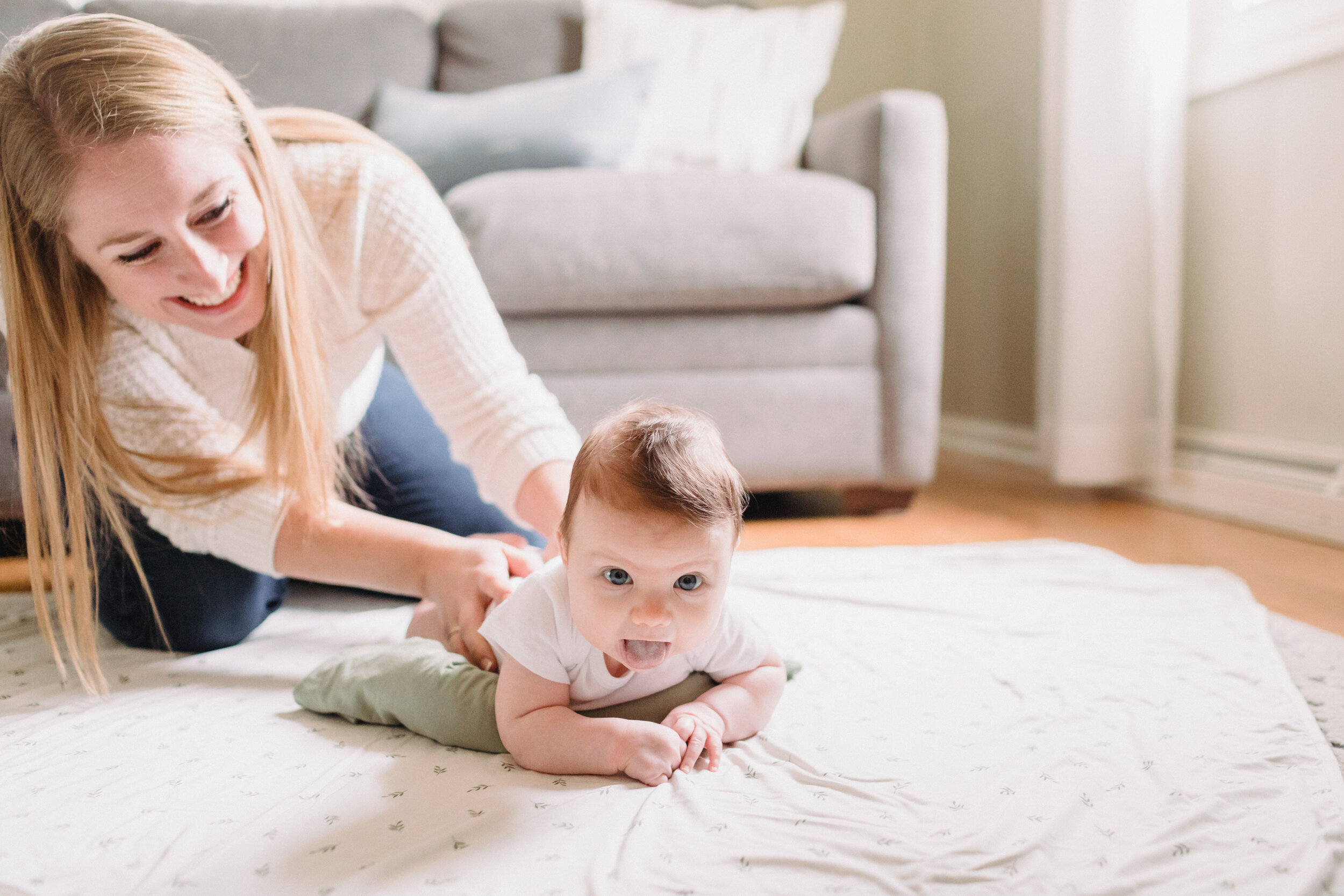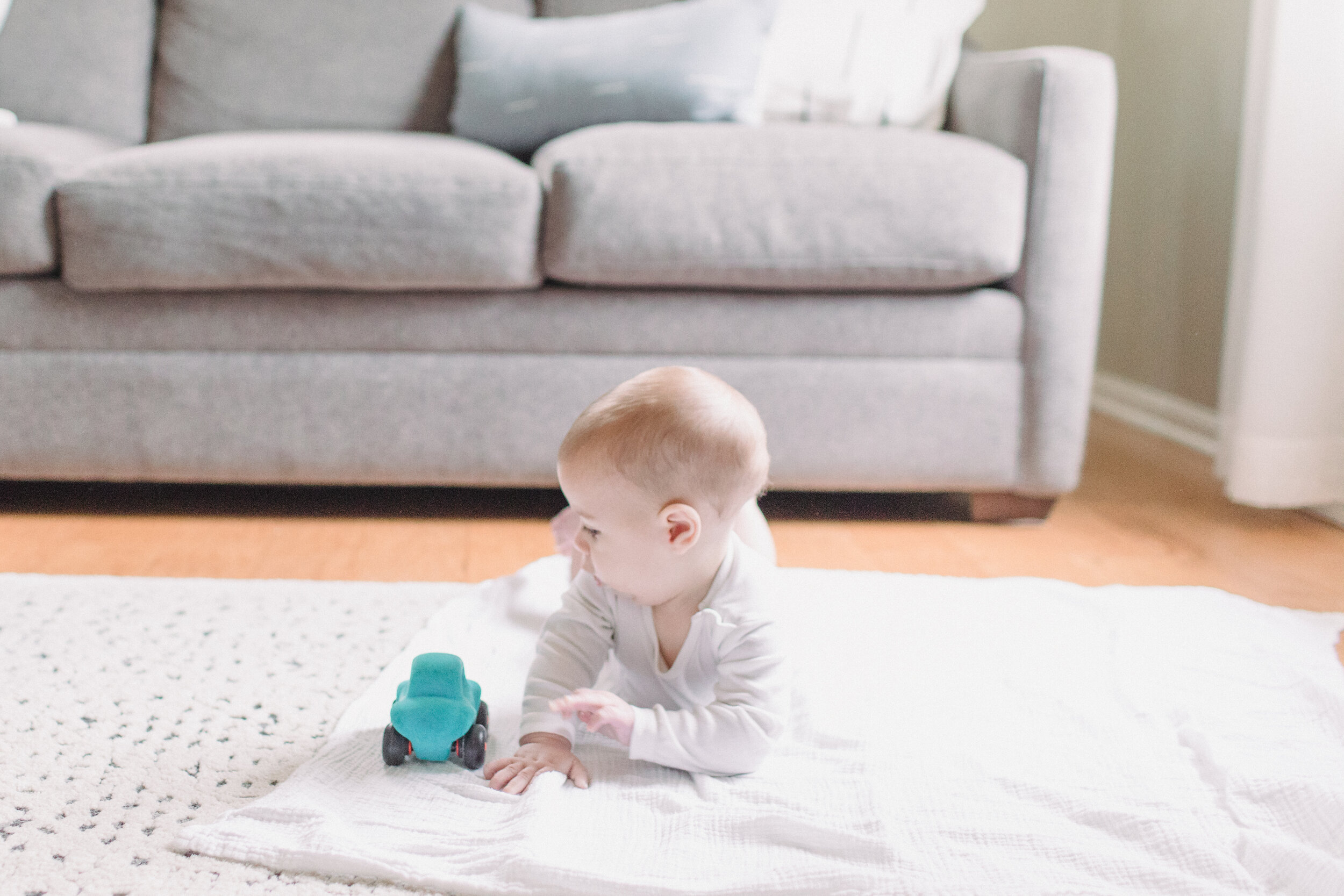What is Tummy Time?
Tummy time (TT) refers to supervised time baby spends placed belly down (prone), on a firm surface, when awake. Baby is encouraged to pick his/her head up from the surface to turn and look at a person, toy, or picture, reach for toys, and eventually begin to pivot on his/her tummy. This is a great time to get down on the floor and engage with your baby to help him/her work on developing the motor, visual and nervous systems.
Why tummy time is important
This position is important because it helps baby to strengthen the neck, back, and shoulder muscles. This strength allows baby to pick up his/her head and look around at the world. It strengthens the back muscles (those that run down the sides of the spine) so that the trunk (body) can eventually support the head and neck when moved into an upright or sitting position.
When baby begins to look to one side or the other in tummy time, he/she is developing increased body awareness, sensory processing skills, midline and crossing midline skills, and honing visual and auditory skills to look toward and locate people and sounds. Baby is working on the sense of touch and learning how to change positions. He/she is laying down neural pathways that will support balance and coordination later in life. This is a TON of work!
Tummy time builds shoulder and chest strength as baby starts to prop his/her self up on the forearms. As babies get older, around 2-4 months, they start to reach and pivot on their belly. This supports arm, wrist and hand strength as well as refining dexterity that they will need later in life to support fine motor skills.
Tummy time also helps baby to develop a nice round head shape. Since the “Back to Sleep” Campaign in 1994, babies are spending more and more time on their backs with pressure placed on the back of the head. Pair that with more time spent in containers (e.g., car seat, bouncer, swing, etc.) and babies now have a very narrow window of time each day to move freely. When our babies can't move freely on the floor and change their positions often, it can lead to a flattening of the back of the head called plagiocephaly. The good news is that our blog is full of play positions and ideas to help you avoid this condition.
Plagiocephaly is due to babies repeatedly having too much pressure on one spot of the head. That pressure can be caused by positioning in utero, but is most often due to spending too much time in containers (car seats, swings, bouncers) instead of being able to freely move about and turn head side to side. When children have this condition, it can require a helmet to reshape the head. Not only is it done to aesthetically reshape the head but this flattening can also affect the face and mouth structures.
Much more on this topic and torticollis (shortening on the neck muscles causing asymmetry) in a future blog post- stay tuned. Bottom line, placing your baby in tummy time gives the back of his/her head a nice rest and allows the body and nervous system to grow and develop as nature intended.
Use our milestone checklists to track your child’s skills and progress and always speak with your pediatrician if you are concerned about your child’s motor development. There are delays and disorders that are unavoidable and require early detection and prompt intervention by a licensed Occupational or Physical Therapist.
How long and how often?
The American Academy of Pediatrics recommends starting tummy time as soon as baby is home from the hospital. We recommend a goal of 2-4 minute chunks 8-10 times a day in the first month and at least an hour total throughout the day by month 3. Try to add it to your routine after each diaper change. Once baby is clean, place him/her belly down on the changing surface, stay close and sing a song or make silly faces so he/she lifts up and watches you. If you add this simple technique into your routine, the minutes will add up quickly! Try tummy time when baby is well rested and avoid it right after a feeding to avoid spit up. If baby cries, try a shorter time or a different variation of the position until you find one they can tolerate, then work toward positions where baby is more challenged. (We’re working on more of these resources for you!)
What baby is working toward
Holding his/her head up to look back at you when held upright
Turning his/her head to look toward a voice or noise in the room
Watching someone walk through the room and maintain head upright
Reaching for items when playing on the floor
Top 3 positions for Tummy Time- Newborn
(see our newborn tummy time blog post here)
*Never leave baby unattended or unsupervised during tummy time
Baby on your chest while you’re in a reclined position in a chair or on the couch/bed with pillows propped behind you.
Lay on the floor very close to baby, talk to him/her and encourage him/her to turn and look for you. Use big facial expressions and a calm and encouraging voice to gain attention.
Across your lap with something to look at books, black and white pictures
Top 3 positions for Tummy Time- baby 1 month +
*Never leave baby unattended or unsupervised during tummy time
Babies of this age can usually tolerate TT for 6-10 minute chunks. Aim for 60-90 min total for the day.
On a boppy or a towel roll - place baby’s hands up by the face with elbows in at the sides. Place gentle pressure on his/her bottom to help move a little of weight off of the chest and into the hips
On the floor/firm surface with books, or noisy touch toys spread around baby
On the floor in front of a mirror
Tummy time is a simple, mess free way to bond with your baby while supporting their development. You’re now empowered with knowledge about why tummy time is important for development and ideas on how to support your baby. Be confident, you do have the skills. Start today, add in a few more minutes of floor time everyday and your baby will thrive.
Bree
We’re Bree & Jaclyn
Pediatric therapists and moms with a mission to empower you with knowledge to encourage your baby’s development and continue confidently into your parenthood journey.
If you have any questions, please feel free to leave a comment below and we will get back to you. As always, the information we share is meant to provide general education and tips and is not intended as medical advice. If you have a specific question or concern about your child’s development, please speak directly to your child’s doctor or therapist.






